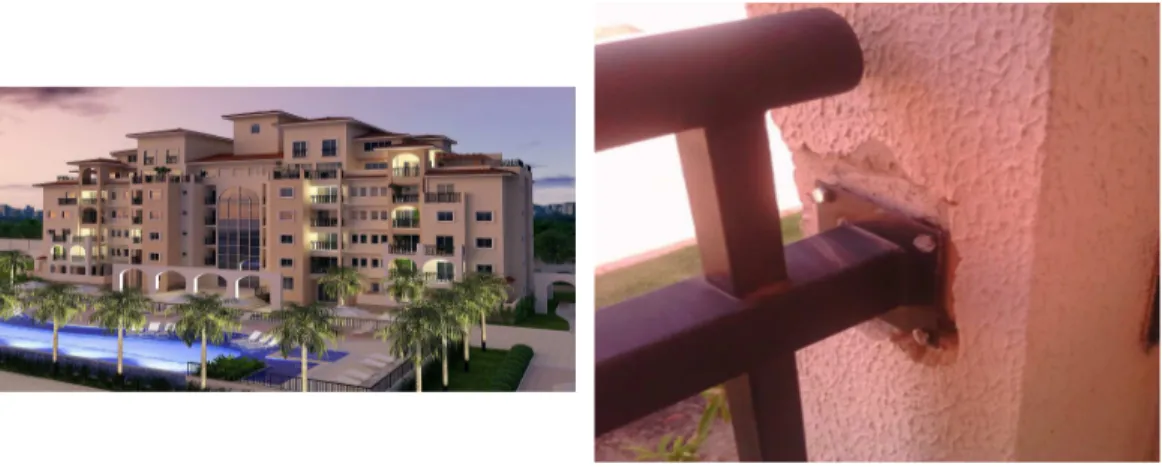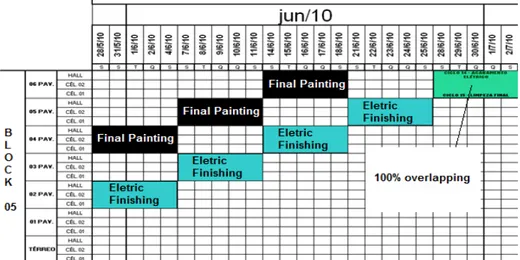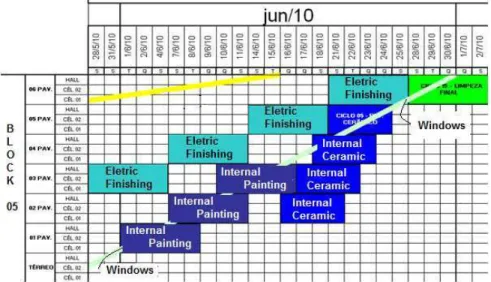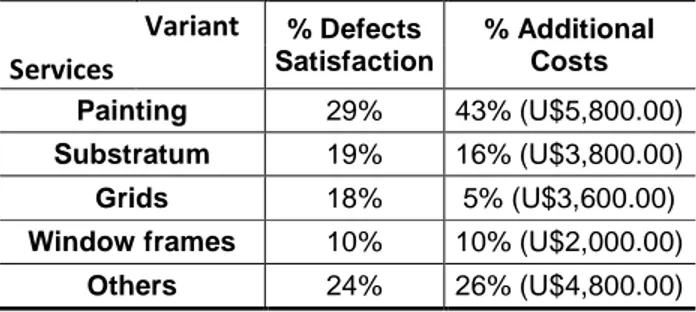Iuri A. de Vasconcelos1, Marcella F. Soares2 and Luiz Fernando M. Heineck3
ABSTRACT
Modern management philosophies as lean construction emphasize continuous flow for processes and operations throughout contract duration. However, many sites are still plagued with discontinuity, erratic flows and overlapping of activities, what occurs in increasing stances as construction activities came to an end and project is overhand to the client. This research work purports to define such concepts and illustrate them in a case study taking as an example a 16,800sqm building development in Fortaleza. A host of methodological avenues are pursued, including photography documentation, line of balance representation, cost evaluation and clients’ questionnaires in connection to the disrupted activities. The hypotheses of this study are related to finding the problematic issues intrinsic to the final stages of construction work. It was found that despite their potential impact to trouble management activities on site, costs associated with their correction were small. Notwithstanding their major outcome was to deliver a fragile and unsatisfactory building as it is signaled by client claims when the project was finally commissioned. Lessons are related to suggest greater efforts in evaluating indirect costs of disrupted activities and the reasons why clients are able to associate them with low quality work and increased maintenance costs.
KEY WORDS
Final Stages of Construction, Erratic Flow, Overlapping and Discontinuity. INTRODUCTION
Examples of genuine efforts to improve management on site are increasingly available (PINHEIRO 2009). For a group of leading construction companies gone are the days when construction was characterizes by a succession of trades trying to overcome problems left behind by their predecessors. However, it is still an open question if work flow, continuity and sequence are firmly obtained and if these management outcomes are homogenously distributed throughout project duration. Forbes examined repetitive house building project undertook in England by the sixties and found that undisturbed flow did occur only for superstructure activities and perhaps masonry, while all the following activities were not able to be
1
Master’s Degree Student, Structural Engineering and Civil Construction Department, 710 Pici University Campus, Univ. of Ceará, Brazil, BR 60455-760, Phone 011-55-88-33669607, iuriav.ufc@gmail.com
2
Master’s Degree Student, Hydraulic Engineering and Environmental Department, 713 Pici University Campus, Univ. of Ceará, Brazil, BR 60451-970, Phone 011-55-88-33669624, marcellafs@gmail.com
3
distinguished one from the other in a line of balance sort of graph. This impossibility of separating flows of work from different activities point to the fact that they were performed in parallel, discontinuously and not following an agreed sequence of work from house to house. At that time lean construction principles were not available, but their common sense roots would recommend better work on a site that was taken as a demonstration project, where proper management skills should possible be into action.
Following the same method of investigation, Heineck (1983) found more disturbing evidences on more three demonstration projects performed in England by the seventies. With no further support at that time from better management tools, like the ones provided by the lean philosophy, this author gave in, concluding that disrupted flows are the standard for even the best managed sites. Further on, Marchiori (1998) investigated Brazilian sites that were undertook by a leading building company that at the time was well reputed for its improvement in one of the TFV areas of concern. Transformation upgrades were the most noticed side of their sites, but flow improvements could also be expected, as they were aware of lean concepts according to Conte (1998). Even so, the same sort of undistinguishable flows of work were observed by Marchiori for the majority of activities.
It seems that the combined effect of complexity, uncertainty in projects and workflow variability creates instability on production processes (HORMAN 2000). What, according to González et al. (2008), directly influence in the levels of planning reliability. González et al. (2008) also states that the relationship between the performance of a project in its execution is related to the planning reliability, which reaches good standards when there is no variability in management commitment. Also, it is important to note that the continuous flow of activities performed by employees shall be provided as a guarantee of planning and control processes reliability, adapting itself to the principles of lean construction (THOMAS ET AL. 2003). These issues were also addressed by Kenley and Seppanen (2010) with extensive case studies for illustration an new production system for construction management using flowline scheduling (Location-Based Management for Construction), which stimulates continuous flow, breaking workflow variability through the use of buffers.
DEFINITIONS
Work disruptions are taken on a purely operational basis as any modification on how the work was planned according to long, medium and short term site programming. In a repetitive site they can be detected by plotting how work was performed using line of balance concepts. In this sense undisrupted work will show continuous lines of progress, a constant rhythm of progress, following predetermined sequences of work from place of work to place of work. Each activity’s line of progress is related to its precedent and succeeding activities such as they do not disturb each others flow of work. Disrupted work is defined by discontinuity, lack of precedence, unbalanced rhythms, out of sequence work within each place of work, and different sequences for the same activity from place of work to place of work. It should be noted that all these so called disruptions might be planned to take place on site: in this situation they will be regarded as undisrupted work, provided that there is good reason for this. For example, an activity might be interrupted for technical reasons, like when forming and concreting pillars previously to beams and slabs, or when gangs are diverted to an apparently out of order place of work in order to finish a prototype model apartment. Disruptions are associated with three major categories, as follows.
Discontinuity is merely the interruption of an ongoing activity in a specific place of work. Preceding and succeeding activities are maintained. In order to finish the job some time in the future the activity should be resumed. As the amount of work to be performed remains the same, discontinuity leads to increased job duration, as productive time is lost during interruption. This amount of time lost can be of the same magnitude of the duration of activity when no interruptions are taken into account. Heineck (1983) found that on average a selected group of activities for the three sites he investigated showed 4 interruptions for each activity in a specific place of work, with an average interruption of 4 days. Thus, activities that would be possible to finish in 16 days took in fact twice that much.
It a quite well established fact that projects are subject to overruns. On the other hand contractual arrangements and penalties put a strong incentive to meet final contract due dates. This puts no other alternative to perform activities in parallel rather than in sequence in order to comply with final project durations less elastic than individual activities’ ones.
Overlapping activities is a kind of disruption that should be taken with caution. As mentioned previously it is a direct consequence of extending individual activities durations and keeping final project contractual date within limits. Overlapping might be advantageous as prescribed by Smith and Reinertsen (1995) and exemplified by Trescastro (2005) for buiding design (Figure 1).
Figure 1: Types of overlapping activities (adapted from Trescastro 2005) In this research disruption due to overlapping occurs when different gangs interfere negatively with each others work, cause work congestion, or damage what is being put into place.
Out of sequence is a category of disrupted work that takes place when precedence relationships are not obeyed in a specific place of work or when places of work are tackled in different sequences for the same activity. It should be remembered that flexible sequences of work are a most desired quality of well designed production processes, what might contribute to overcome residual variability in the circumstances that create the environment where work takes place. Not everything might be controlled, hence flexibility allows a less strict adherence to what has been planned.
Out of sequence for the purposes of this research work will be detrimental to site programming when it imposes making do activities (without prior planning) in the work place that is being unexpectedly visited. By the same token, it imposes making do activities in connection to previous or next activities to the one that was unexpectedly intercalated among them.
The most evident out of sequence work can be termed erratic flow. This is what be depicted in a line of balance kind of progress chart showing each activity following a particular flow from work place do work place. As with the discussion on discontinuity, provide there is final less elastic contractual due date it is mathematically mandatory that activities should be done in out of sequence or in parallel within each work place. Heineck (1983) was not able to find a stable ordering of work places to be attacked in the three demonstration projects he investigated, despite the fact that at least it was possible to figure out a general sense of a unique work flow direction for groups of activities.
This section on definitions ends by exploring the concept of final stages of construction work. No definition was found in the literature on how far this period of work extends. Learning effect research efforts call attention to a phenomenon that can be taken as a surprise. Final repetitions are performed with increased durations and labor content than the preceding ones that successfully benefited from learning effect. Despite the fact that this finding suggests further research on the psychological and operational aspects that make it difficult to perform latter work it does not apply for the discussion in hand as it deals with identical activities performed in sequence.
as MISWARs. For example, durations are in the range 1:20 when going from MISWAR=1 to MISWAR=32. Moreover resource allocation follows classical ABC cost curves: some 60% of total manhours were deployed in a small group of 10% of weeks with larger manpower allocation; another 30% of total manhours were deployed in a second group of weeks that perform 30% of all weeks in which work took place. Summing up, this is to say that 90% of all manhours were allocated in 40% of the duration of work. Taking for the sake of reasoning that these substantial effort weeks were concentrated around half the elapsed duration, it comes that 30% of the activity duration was performed in its initiating tail and 30% in its finishing one. End of work period, for this example takes almost one third of the entire activities duration, with progress seemingly difficult to attain during this latter time, as exemplified by the fact that only 5% of manhours are left to be deployed during the period. This is the same that to state that 95% of the effort was applied during the first 2/3 of activity’s duration.
A different view is obtained when defining the final stages of construction as the period when purposefully the majority of costs are incurred. According to standard S curves propositions, the second half duration is associated with 50% of resources being allocated. This might be associated with wet and dry construction periods, or rough and finishing ones, that accordingly took half the duration and project resources. The previous leading residential building construction company in Brazil, ENCOL, once proposed that postponing resource’s allocation goes in line with better cash flow management. This has been reinforced by JIT concepts that suggest leaving for the last responsible moment the allocation of major resources on site. ENCOL proposed dividing resource allocation in two periods: the first comprising 75% of contract duration corresponding to just 50% of resources; the last one, taking the remaining 25% of total duration and the remaining 50% of all resources. According to this, final stages of construction can be associated with this last than 1/3 period of the total project duration.
In the absence of a clear definition, final stages were defined as the ones performing 6 months prior to project handover. Estimated project total duration was 36 months. As a qualitative remark, the 5 tower blocks with 7-stories were all concluded, in terms of masonry, rendering, flooring, electrical and plumbing installations, doors and windows hanging and first painting coating. Remaining effort was related to external works (garages, condominium area, pathways, gardens and site utilities). Apartments remaining work was related to painting final coats, fixing electric and hydraulic appliances, ironmongery, cleaning and making ready activities.
METHODOLOGY
A 16,800 sqm development, with 5 towers blocks (7-story) and a total of 208 apartments was investigated. Figure 2 gives an overview of the housing development. It represents a different approach to medium class apartment building in Fortaleza as the state is made of a composition of different blocks were façades are not homogeneous. Balconies produce a façade differentiation between blocks, while providing deeper ventilation and keeping the apartments from direct sun contact.
from April 2010. Research results are to be described in the following sections, covering qualitative findings derived from photographic documentation of work disruptions, comparisons between planned and actual line of balance depicting work progress, handover checklists produced by clients at the time they were officially receiving apartments from the building company and cost reports in connection with repairing disrupted work and client’s bad quality claims.
PHOTOGRAPHIC DOCUMENTATION
During the time period observations were under way the authors collected a data bank comprised by unusual activity found on site. Unusual activities are occurrences that were not expected according to traditional patters of work progress on site. For each photograph of a deemed unusual work an explanation was sought as related to the causes and consequences of its timing. Most of the explanations were connected to disrupted work, as defined previously.
Activities related to balcony’s ironmongery grids are a good example of disrupted work. Those building components were not standardized, due to the fact that every balcony has its specific dimensions and features, what gives façades an architectural uniqueness. Problems with grid’s supply demanded their installation after rendering and painting as illustrated by Figura 3. This out of sequence work caused quality problems, as a simple bolt fixing was substituted for dimensionally adapting each grid to the remaining balcony width, after variable rendering and painting thickness took part of the available space for the prefabricated grids.
Figure 4: Improper storage of materials LINE OF BALANCE CONTROL
Part of the disrupted work was evident from line of balance control charts, comparing what was planned (Figure 5) with actual developments on site (Figure 6). Figure 6 shows that internal ceramic tiling being performed after internal painting while windows and doors were installed in parallel to painting. This contrary to usual technical precedence recommendations, as painting should occur after apartments are weatherproofed and all wet activities, like tiling, are finished. Performing them in opposition to common sense beliefs will end up with rework in connection to all three activities, painting, windows and doors hanging and tiling, as different trades will damage and mess each other’s work.
Figure 6: Actual developments on site COST CONTROL
All possible disrupted work spotted in photographs or line of balance control charts were evaluated in terms of costs. Generally speaking only labor costs were taken into account as materials like extra mortar, painting, electrical wires, PVC plumbing connections, plasterboard and ceramic tiles are either relatively inexpensive or used in small quantities. Monthly costs are depicted in Figure 7 both as individual and cumulative numbers.
Figure 7: Additional costs of reworks
It is worth pointing out that 704 cases of disrupted work summed up only R$ 34,243.00 (US$ 20,000.00) of labor costs, compared to a R$ 5,000,000.00 (US$ 2,900,000.00) budget for manpower, what represents less than 0.7% of labor. Total development cost was about R$ 15,000,000.00 and total selling price in the region of R$ 25,000,000.00 (on average R$ 100,000.00 – US$ 60,000.00 - per apartment) what decreases still further the direct economical impact of disrupted work.
FINAL HANDOVER CLIENT’S CHECKLISTS
Near the contractual handover date, site management calls each individual apartment building client to fill up a checklist that contains all possible claims on lack of quality or malfunction. This contractual procedure does not prevent future claims in connection with hidden defects or that might become apparent only when the building is put into use. Notwithstanding this checklist is to be taken rigorously as clients will normally need to argue more fiercely with the building company in order to repair defects that were not spotted at this particular moment.
A total of 704 defects were claimed through the checklist filled by 208 clients, representing an average of 3.4 per apartment. Table 1 below compares the incidence of claims and the percentage of costs to make good disrupted work.
Table 1: Nexus between the percentage of defects and major additional costs Variant % Defects
Satisfaction
% Additional Costs
Services
Painting 29% 43% (U$5,800.00)
Substratum 19% 16% (U$3,800.00)
Grids 18% 5% (U$3,600.00)
Window frames 10% 10% (U$2,000.00)
Others 24% 26% (U$4,800.00)
It should be noted that additional costs were incurred to make good disrupted work in order that they will become unnoticed by clients. The fact that the there is a direct relationship between these percentages indicates that despite the making good efforts part of the disrupted work still remains as bad quality and malfunctioning parts of the building. It is obvious that other causes for clients spotting defects in connection with those activities might be operating, like difficult architectural details, bad workmanship or bad material’s quality.
The authors firmly believe that making good disrupted work is a cause of bad quality and a fragile outlook for a number of architectural details.
CONCLUSIONS
Continuity, synchronized flows of work, adherence to well defined and standardized sequences of work are cornerstones for the lean construction philosophy. This research work maintains that they are not easily achieved even on a site were management experience on TFV concepts could be expected. Failing to apply them results in work disruptions characterized by discontinuity, out of sequence and overlapping activities as defined in this research work. Despite their significant quantitative occurrence, work disruptions did not amounted to significant costs, what might be taken as a lack of incentive for managers to improve their abilities in promoting a lean production environment for better work.
devoted to the end of construction period due its possible greater interaction with clients and perceived quality of the final building.
This research work concludes that incentives for lean application should be sought in quality problems and claims affecting clients. At the end, remedial work as presented by the site under investigation can affect building company’s reputation on the market. Market orientation rather than cost optimization is suggested as a stronger motivation for lean production.
ACKNOWLEDGEMENTS
This paper was made possible by the support provided by CAPES/PROPAG. REFERENCES
Conte, A. S. I. (1998). “Last planner, look ahead, PPC: a driver to the site operations.” Proceedings of the Eighth Annual Conference of the International Group for Lean Construction (IGLC-6), Guaruja, Brazil.
González V., Alarcón L.F , Mundaca F. (2008) Investigating the relationship between planning reliability and project performance. Production Planning & Control, July, 19, 5, 461-474.
Heineck, L. F. M. On the Analysis of Activity Durations on Three House Building Sites. Doctoral Thesis, The University of Leeds. 1983.
Horman, M. J. (2000). Process Dynamics: Buffer Management in Building Project Operations. Ph D Dissertation, Faculty of Architecture, Building and Planning, The University of Melbourne, Melbourne, Australia.
Kenley, R. and Seppänen, O. (2010). Location-based Management in Construction: Planning, Scheduling and Control. Spon Press, London and New York, 554 pp.
Marchiori, F. F. Estudo da produtividade e da descontinuidade no processo produtivo da construção civil: um estudo de caso para edifícios altos. 1998. 103p. Dissertação (Mestrado em Engenharia) – Universidade Federal de Santa Catarina, Florianópolis, 1998.
Pinheiro, M.B. Considerações Gráficas sobre a ligação entre a linha de balanço e o Sistema Toyota de Produção. 2009. Monografia (Graduação em Construção Civil) – Faculdade de Engenharia Civil, Universidade Federal do Ceará, Fortaleza. Smith, P. G.; Reinertsen, D. G. Developing products in half the time. New York, Van
Nostrand Reinhold, 1995.
Thomas, H. R., Horman, M. J., Minchin, R. E. and Chen, D. (2003). Improving Labour Flow Reliability for Better Productivity as a Lean Construction Principle. J. Const. Engr. Mgmt., ASCE, Vol 129, N° 3, pp. 251-261.




